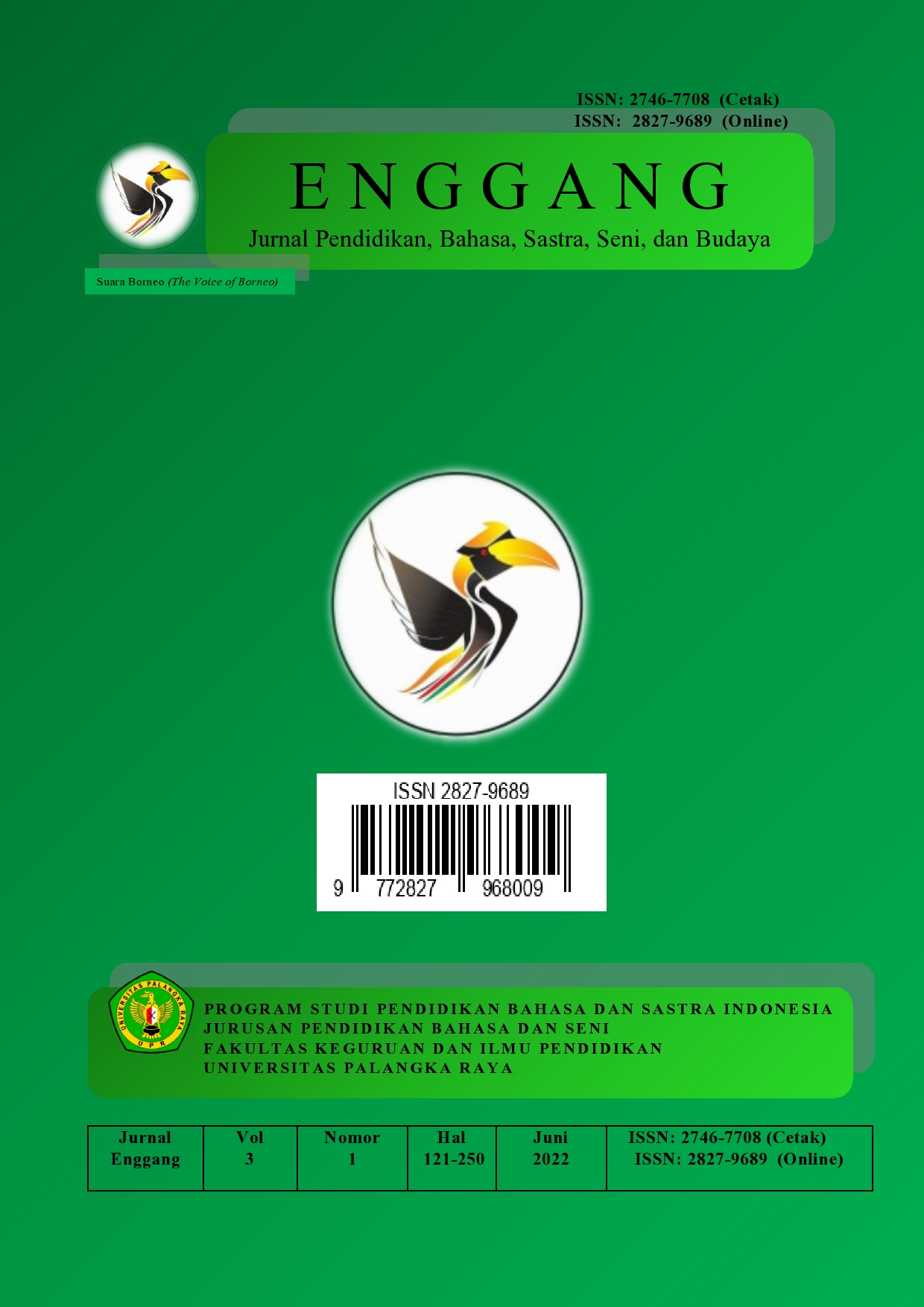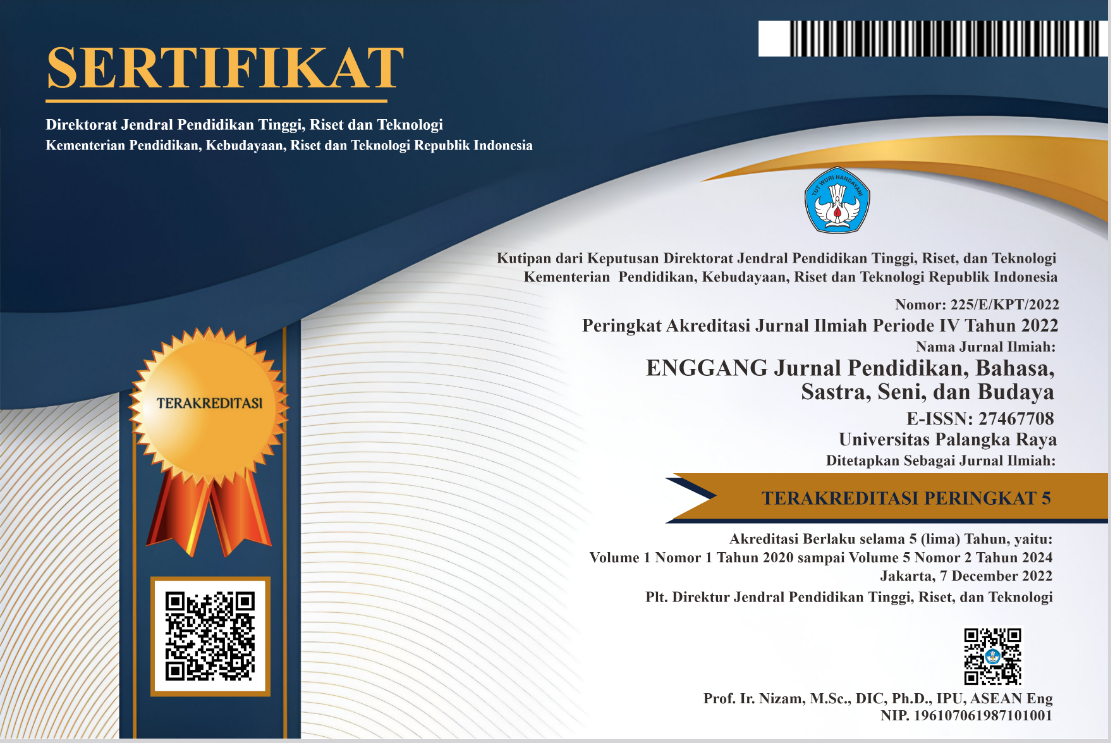Proses Kreatifitas Penciptaan Original Soundtrack pada Teater Musikal Wahyu Psikadelika Karya Nanda Darius
DOI:
https://doi.org/10.37304/enggang.v5i2.22188Keywords:
Creative Process, Musical Theatre, Role, SongAbstract
This research aims to find out in depth about the creative process carried out by the director and also the composer in making OST in the Wahyu Psikapdelika musical theater, using a qualitative approach method, namely ethnography with Wallas's concept theory (1926), using 4 stages of the inner process consisting of preparation, incubation, enlightenment, and verification. Data collection in this study used interview techniques, observation, data analysis, and documentation as concrete evidence of the existence of this research using Wallas' conceptual foundation. This research aims to find new ideas about how a director's creative process makes OST with his epic mystagogia method. The results of this study will discuss what processes are needed in making the original soundtrack in the Wahyu Psikapdelika script, several pieces of verse that are not mature and have not been made into a song or OST, then presented several pieces of sheet music containing arrangements and compositions resulting from the making of OST, then the techniques used in the process. It can be concluded that the creative process in this research produces an idea that is contained in the original soundtrack or OST which is used to support the aspects of theme and atmosphere in Wahyu Psikapdelika Musical Theater.
Downloads
References
Annan, J. F. (2024). The juncture of musical theatre and theatrical music: A literature review. IOSR Journal of Humanities and Social Science, 29(10), 15–18. https://doi.org/10.9790/0837-2910051518
Brook, P. (1968). The empty space. Peter Brook. (lembar 1–103) (Catatan: Jika halaman tidak diperlukan, bisa dihapus)
Cenkerová, Z. (2017). Melodic segmentation: Structure, cognition, algorithms. Musicologica Brunensia, 1, 53–61. https://doi.org/10.5817/MB2017-1-5
Chronopoulou, A. (2022). Music in the service of the directorial vision: The case study of the theatrical performance of Acharnians in 1976 by the Greek Art Theatre (Theatro Technis). 8th International E-Conference on Studies in Humanities and Social Sciences: Conference Proceedings, 33–46. https://doi.org/10.32591/coas.e-conf.08.03033c
Putri, F. A., & Yuhdi, A. (2023). Analisis makna konotasi dalam lirik lagu “Sampai Jadi Debu” karya Ananda Badudu. ENGGANG: Jurnal Pendidikan, Bahasa, Sastra, Seni, dan Budaya, 4(1), 247–260. https://doi.org/10.37304/enggang.v4i1.12137
Galbreath, D. J. (2019). Conceptualising choral play: The creative experience of aleatory choral music (Doctoral dissertation, Royal Birmingham Conservatoire). Volume I. (Januari). https://www.open-access.bcu.ac.uk/id/eprint/8763
Herlangga, S. A., Putra, B. A., & Setyoko, A. (2021). Proses kreativitas dan penerimaan masyarakat: Studi kasus musik pengiring jaranan. Jurnal Mebang: Kajian Budaya Musik dan Pendidikan Musik, 1(2), 69–80. https://doi.org/10.30872/mebang.v1i2.9
Ichim, D., Szőcs, B., & Drăgulin, S. (2024). [Judul tidak tersedia—lengkapi.] [Nama Jurnal, 17(1), hlm.]*
McLeod, N., & Merriam, A. P. (1965). The anthropology of music. In Anuario, 1. https://doi.org/10.2307/779807
Noviandri, R. (2024). Pemeranan tokoh Sherina dalam drama musikal Petualangan Sherina 2 karya Riri Riza. [Nama Jurnal Musaikut].
Perchard, T., Graham, S., Johnson, T. R., & Rogers, H. (2022). Harmony. In Twentieth-Century Music in the West (hal. 179–201). Cambridge University Press. https://doi.org/10.1017/9781108680899.008
Petermann, D., Chandna, P., Cuesta, H., Bonada, J., & Gómez, E. (2020). Deep learning–based source separation applied to choir ensembles. Proceedings of the 21st International Society for Music Information Retrieval Conference (ISMIR 2020), 869–875.
Rangkuti, A. N. (2019). Metode pendidikan penelitian: Pendekatan kuantitatif, kualitatif, PTK, dan penelitian pengembangan. [Penerbit?].
Roggema, R., & Heester, J. (2023). The art of improvisation. In Contemporary Urban Design Thinking (Part F8, hal. 217–224). https://doi.org/10.1007/978-3-031-21456-1_23
Sadler Smith, E. (2015). Wallas’ four-stage model of the creative process: More than meets the eye? Creativity Research Journal, 27(4), 342–352. https://doi.org/10.1080/10400419.2015.1087277
Soedarso, S. P. (2006). Trilogi seni: Penciptaan, eksistensi, dan kegunaan seni. Badan Penerbit ISI Yogyakarta.
Thompson, P. (2019). The creative system of songwriting. In Creativity in the Recording Studio (hal. 117–147). Springer International Publishing. https://doi.org/10.1007/978-3-030-01650-0_6
Vanacova, S., & Nugroho, E. (2023). Peningkatan kreativitas anak melalui regenerasi seni gejog lesung di Dusun Kowang Puton, Kalurahan Trimulyo, Kapanewon Jetis, Kabupaten Bantul. ENGGANG: Jurnal Pendidikan, Bahasa, Sastra, Seni, dan Budaya, 3(2).
Young, G., & Roens, S. (2022). Insights into music composition. Routledge. https://doi.org/10.4324/9781003205869
Zasna, M., Yusril, Y., & Sulaiman, S. (2019). Drama musical Sepatu Kaca. Besaung: Jurnal Seni, Desain, dan Budaya, 4(1). https://doi.org/10.36982/jsdb.v4i1.588
Zenita, R., Pratama, Z. W., & Setyoko, A. (2023). Musik salating sebagai wujud kreativitas kelompok Kuarsa Mahakam di Kota Samarinda. Jurnal Mebang: Kajian Budaya Musik dan Pendidikan Musik, 3(2), 93–108. https://doi.org/10.30872/mebang.v3i2.56













